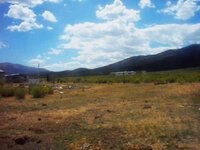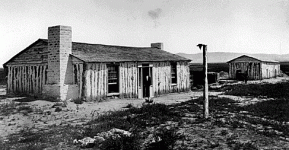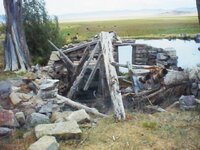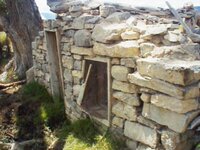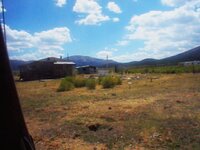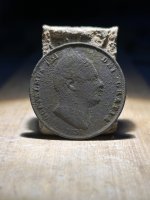Gypsy Heart
Gold Member
1862 Fort Ruby 1869
"Colonel P. Edward Conner was ordered to build and command this post in 1862. The Fort was built midway between Salt Lake City, Utah and Carson City, Nevada to protect the Overland Mail route (Pony Express) and emigrant travelers from Indian raiders. Most Army outposts of this time were built in remote areas, but this post was classified by the Army as the "Worst Post in the West." In 1869 the completion of the Transcontinental Railroad brought an end to the Pony Express, and the need for this Fort. Post Commander Captain Timothy (last name of Connelly omitted here) was ordered to close the Fort. He and his men returned the "Worst Post in the West" back to the Nevada desert in 1869."
Fort Ruby 1862 - 1869. Courtesy of Stanley W. Paher from his Nevada Ghost Towns & Mining Camps and Jerry B
A History of Fort Ruby
In May 1860, Co. B of the 4th Artillery assigned to Camp Floyd, Utah, was sent to Ruby Valley to find and establish a camp base to use to protect the Overland Mail Route and its passengers and others from Indian attacks. On Sept. 4, 1861, Col. E. P. Connor organized the 3rd Regiment of California Volunteers. A year later he received orders to patrol the Central Route of the Overland Mail Company. The site chosen for Fort Ruby is on the eastern side of the southern end of the Ruby Mountains in Ruby Valley, Nevada. The Fort was situated about 2 1/2 miles southeast of the Overland Mail Station on a six square mile plot of ground. The Fort's northern boundary was on the dividing line between what are now Elko and White Pine Counties in Nevada. The site was approximately midway if the 600 miles separating Carson City, Nevada and Salt Lake City, Utah.
Col. Edward P. Connor and seven companies of soldiers (about 600 men), 55 wagons, 2 howitzers, carriages for some of the officer's families, 3 ambulances and the regimental band departed Camp Halleck, Stockton, California, on July 12, 1862, and began marching east. They arrived at Fort Ruby on the evening of September 1, 1862. Fort Ruby was officially established pursuant to orders # 8 dated September 4, 1862 by Col. Connor.
Soldiers immediately began to gather stone and timber from the nearby mountains to build store houses and winter quarters. Living quarters were log cabins of hand hewn logs either laid horizontally or vertically and heated by fireplaces. Stables and store houses were built of vertical logs in a stockade fashion with the posts set vertically in trenches. Corrals were constructed of adobe. A good sized pond, fed by a spring, supplied the Fort with fresh water.
Photographs taken in 1868 by Tim O'Sullivan, a member of King's Survey party, show that at least two of the officer's quarters were built with vertical logs, caulked with adobe, had shingled roofs, 2 brick fireplaces, and 2 double-hung windows in each building. When the Fort construction was completed, there were approximately 14 white washed log buildings comprising the Army's quarters and several other log cabin outbuildings. In 1858, the only two original buildings remaining showed evidence of having 3" tongue and groove wainscoting in their interiors.
http://www.webpanda.com/white_pine_county/historical_society/ft_ruby.htm
http://www.greatbasinheritage.org/rubylake.htm
"Colonel P. Edward Conner was ordered to build and command this post in 1862. The Fort was built midway between Salt Lake City, Utah and Carson City, Nevada to protect the Overland Mail route (Pony Express) and emigrant travelers from Indian raiders. Most Army outposts of this time were built in remote areas, but this post was classified by the Army as the "Worst Post in the West." In 1869 the completion of the Transcontinental Railroad brought an end to the Pony Express, and the need for this Fort. Post Commander Captain Timothy (last name of Connelly omitted here) was ordered to close the Fort. He and his men returned the "Worst Post in the West" back to the Nevada desert in 1869."
Fort Ruby 1862 - 1869. Courtesy of Stanley W. Paher from his Nevada Ghost Towns & Mining Camps and Jerry B
A History of Fort Ruby
In May 1860, Co. B of the 4th Artillery assigned to Camp Floyd, Utah, was sent to Ruby Valley to find and establish a camp base to use to protect the Overland Mail Route and its passengers and others from Indian attacks. On Sept. 4, 1861, Col. E. P. Connor organized the 3rd Regiment of California Volunteers. A year later he received orders to patrol the Central Route of the Overland Mail Company. The site chosen for Fort Ruby is on the eastern side of the southern end of the Ruby Mountains in Ruby Valley, Nevada. The Fort was situated about 2 1/2 miles southeast of the Overland Mail Station on a six square mile plot of ground. The Fort's northern boundary was on the dividing line between what are now Elko and White Pine Counties in Nevada. The site was approximately midway if the 600 miles separating Carson City, Nevada and Salt Lake City, Utah.
Col. Edward P. Connor and seven companies of soldiers (about 600 men), 55 wagons, 2 howitzers, carriages for some of the officer's families, 3 ambulances and the regimental band departed Camp Halleck, Stockton, California, on July 12, 1862, and began marching east. They arrived at Fort Ruby on the evening of September 1, 1862. Fort Ruby was officially established pursuant to orders # 8 dated September 4, 1862 by Col. Connor.
Soldiers immediately began to gather stone and timber from the nearby mountains to build store houses and winter quarters. Living quarters were log cabins of hand hewn logs either laid horizontally or vertically and heated by fireplaces. Stables and store houses were built of vertical logs in a stockade fashion with the posts set vertically in trenches. Corrals were constructed of adobe. A good sized pond, fed by a spring, supplied the Fort with fresh water.
Photographs taken in 1868 by Tim O'Sullivan, a member of King's Survey party, show that at least two of the officer's quarters were built with vertical logs, caulked with adobe, had shingled roofs, 2 brick fireplaces, and 2 double-hung windows in each building. When the Fort construction was completed, there were approximately 14 white washed log buildings comprising the Army's quarters and several other log cabin outbuildings. In 1858, the only two original buildings remaining showed evidence of having 3" tongue and groove wainscoting in their interiors.
http://www.webpanda.com/white_pine_county/historical_society/ft_ruby.htm
http://www.greatbasinheritage.org/rubylake.htm



